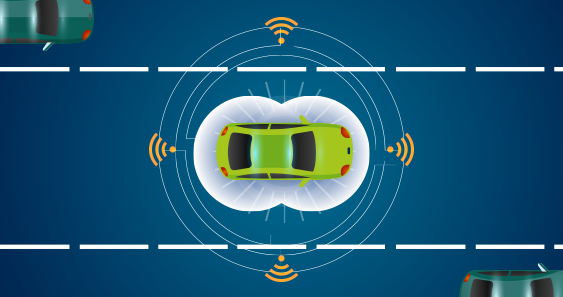Advanced driver assistance systems are becoming increasingly common in new vehicles. In fact, many such systems are actually now a legal requirement in the UK. This is due to the significant safety increase they provide on the roads.
What is ADAS?
Advanced driver assistance systems or ‘ADAS’ are technologies installed in your vehicle which increase safety and comfort whilst driving. Using highly calibrated sensors and cameras, this technology cleverly automates some of the more difficult aspects of driving.
The aim of these systems is to mitigate human error in driving and streamline your experience. Studies have suggested that ADAS would reduce road accident frequency by 23.8%, which is why it is absolutely vital to make sure you get your ADAS calibrated regularly. Read our dedicated blog to learn more about ADAS calibration.
ADAS Features
Below is a list of some of the main ADAS features:
- Blind spot detection – Using cameras and sensors, ADAS can warn drivers of other vehicles/obstacles which are not visible to the driver.
- Lane assist – Sensors detect the lane in which the vehicle is being driven. If the system detects that the car is drifting out of the intended lane, the system can either warn the driver of this issue, or in some cases it will activate steering assist to automatically put the vehicle back on the right course. Often, this feature only activates when the car is travelling at or above a certain speed.
- Emergency braking – If ADAS detects an imminent collision, it will automatically apply the brakes to minimise damage/injury. Being a highly intelligent system, this does not always mean applying the brakes at maximum, as sometimes this may actually cause more damage.
- Adaptive cruise control – Adaptive cruise control is a system which allows the driver to select a speed and the car will maintain it whilst using sensors to ensure a safe distance from other vehicles as well as safe driving patterns. This system will also take factors such as traffic and driver fatigue into account to adjust speed accordingly.
- Parking assistance – Using sensors and cameras, ADAS streamlines the parking process either by showing on a visual display the position of the vehicle parked behind, or by sounding/beeping at a rate based on distance from other vehicles. In some cases, ADAS can actually provide entirely automatic parking.
Does every car have ADAS?
It is a legal requirement that all new vehicles are fitted with certain ADAS features. However, it is not legally required for all existing vehicles to have these systems. Many older vehicles will not be fitted with any ADAS features.
As time progresses, the UK government intends to add more regulations, working in phases towards every vehicle being equipped with ADAS to increase road safety and decrease road traffic accidents across the country.
If your vehicle is fitted with ADAS, you likely already know and use its features. However, if you want to check whether your vehicle has any such systems, it is a good idea to check your purchase record, or contact the garage you purchased the car from for more information.

Is ADAS safe?
ADAS is widely accepted to increase the safety of driving. Each feature is specifically designed to reduce the danger and difficulty of one or another aspect of driving, and using ADAS will make you a safer driver.
Not only does ADAS aim to reduce the likelihood of incidents occurring, it also aims to reduce the severity of an unavoidable one. This might be through applying the brakes just before a collision, or performing automatic emergency stops after a collision.
However, it is important to note that poorly calibrated ADAS could cause some issues. It is therefore important to seek calibration after any incident/event which may impact its accuracy. Such incidents include accident damage/repairs, windscreen replacement, suspension adjustments and even software updates. Whilst unlikely, any of these things could cause certain problems with your ADAS.
Potential ADAS Issues
It is likely that the only issues you will ever experience when using ADAS features will be caused by a lack of adequate calibration of the system. Uncalibrated ADAS can fail to work properly, causing malfunctions with safety features.
Whilst this is very rare, it can lead to complications such as missed warnings or false alarms. This means the system may flag an issue that isn’t actually there, or it could fail to flag danger to the driver.
On top of this, driving with improperly calibrated ADAS can cause insurance complications, or even legal issues. To avoid this, ensure you book ADAS recalibration every time your car is involved in any of the previously mentioned incidents.

